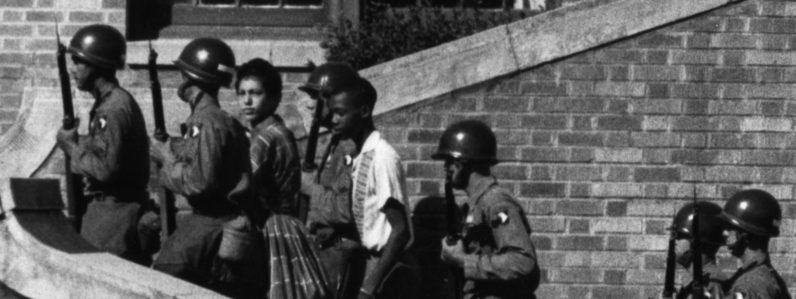Aims & Purpose
According to the United States Constitution, the Supreme Court serves as the highest court in the country. As the Constitution states in Article III, “Section I. The judicial Power of the United States, shall be vested in one supreme Court, and in such inferior Courts as the Congress may from time to time ordain and establish.”
This 120-minute lesson focuses on the history and operation of the United States Supreme Court. Students will learn about the power of judicial review and how the court’s decisions impact society and their daily lives. This lesson supports the New York State social studies framework generalization:*
- CONSTITUTIONAL FOUNDATIONS (1763-1824): Growing political and economic tensions led the American colonists to declare their independence from Great Britain. Once independent, the new nation confronted the challenge of creating a stable federal republic.
11.2d. Under the new Constitution, the young nation sought to achieve national security and political stability as the three branches of government established their relationships with each other and the states.
*Taken from: New York State K-12 Social Studies Framework for grades 9-12 (New York State Education Department, 2014), p. 35.
Concepts
Civic values
Justice
Due Process of Law
Judicial Review
Skills
Gathering, Using, and Interpreting Evidence
Identify, describe, and evaluate evidence about events from diverse sources.
Deconstruct and construct plausible and persuasive arguments using evidence.
Chronological Reasoning and Causation
Articulate how events are related chronologically to one another in time and explain the ways in which earlier ideas and events may influence subsequent ideas and events.
Comparison and Contextualization
Identify, compare, and evaluate multiple perspectives of a given historical experience.
*Taken from: New York State K-12 Social Studies Framework (New York State Education Department, 2014), pp. 14-16.
Setting the Stage, Introduction & Background
60 minutes
Have students review the United States Constitution’s description of the duties and powers assigned to the Supreme Court. Provide small groups of students with copies of Article III of the United States Constitution and have each group list the powers assigned to the Supreme Court.
Provide student groups with copies of the Robert H. Jackson Center publication, “The Constitution and Its Courts,” (2003).
Students can also visit www.annenbergclassroom.org and search under “Videos” for the video entitled, “ A conversation on the origin, nature, and importance of the Supreme Court,” with Chief Justice John G. Roberts (37min.). Have students explain the history of the Supreme Court, how it established the principle of judicial review, its powers, how it operates, and the impacts of its decisions on American society.
Students may also read, “The Supreme Court,” taken from: Gail Jarrow, Robert H. Jackson: New Deal Lawyer, Supreme Court Justice, Nuremberg Prosecutor (Calkins Creek, 2008), p. 43.
Students may also visit:
Importance of Supreme Court Decisions
30 minutes
Have student groups or individual students select a landmark United States Supreme Court decision from the New York State K-12 Social Studies Framework. These cases include:
Marbury v. Madison (1803)
McCulloch v. Maryland (1819)
Worcester v. Georgia (1832)
Plessy v. Ferguson (1896)
Schenck v. United States (1919)
Korematsu v. United States (1944)
Brown v. Board of Education of Topeka (1954)
Heart of Atlanta Motel, Inc. v. United States (1964)
Gideon v. Wainwright (1963)
Miranda v. Arizona (1966)
Engel v. Vitale (1962)
Tinker v. Des Moines School District (1969)
New Jersey v. TLO (1985)
Using the case study method, have students prepare a brief of the case by answering the Case Study Method Questions.
In addition to those websites included under activity 1, students can also gather information about these cases at:
www.annenbergclassroom.org/files/documents
Case Study Method Questions
*Taken from: Tiffany Middleton, “How to Read a U.S. Supreme Court Opinion,” Social Education, National Council for the Social Studies, January/February 2013, pp. 32-35. For the full article visit: www.socialstudies.org and search Social Education, January/February 2013
The United States Supreme Court Today: Writing Assignment
30 minutes
Have students identify an important legal issue facing the United States Supreme Court today such as immigration, voting rights, fair housing, affirmative action, or the limits of the first amendment. Students may visit www.supremecourt.gov or http://www.supremecourtpreview.org for other issues under consideration by the Court. Students can debate the pros and cons of the issues. Ask students to discuss the importance of checks and balances in maintaining our democratic republic. What role does the Supreme Court play in protecting the system of checks and balances? What should be the criteria for selecting someone to serve as a Justice or Chief Justice on the Court? What advice would Robert Jackson give future presidents about how to select Supreme Court nominees?
LESSON PLAN RESOURCES
- C-Span, Landmark Cases of the United States Supreme Court
-
search under “The Courts”


